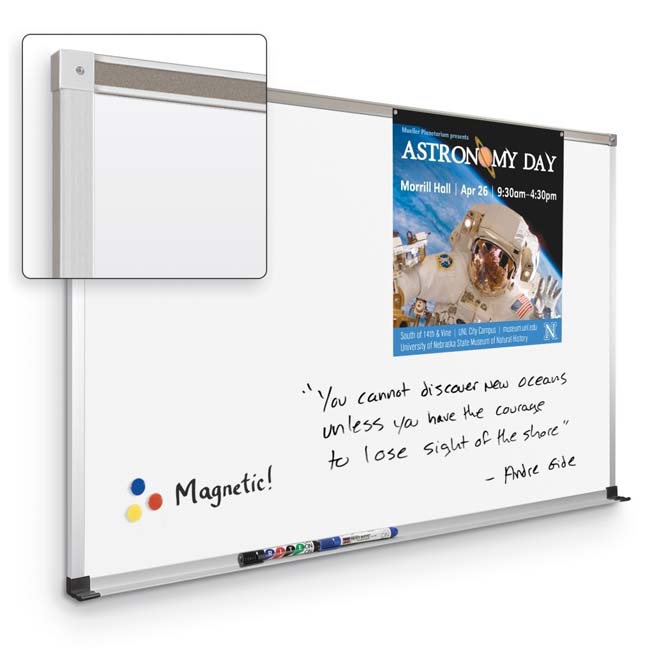Back in the day, you would have a blackboard made of black slate or wood, in front of a classroom onto which you would use chalk to write information, whether it was the teacher or the student. This created a lot of mess, not to mention the chemicals present in the chalk dust are harmful to everyone that came into contact with it regularly. It was a messy and dirty process to have to wipe down the board every time you wrote on it, and most of the chalk dust would get onto your hands, hair, face and clothes.
We used them as they were the only resources available to us at the time. However, there were many disadvantages of using this and a lot had to also do with the material itself, which was a temporary item that would go through wear and tear over years of use. The dark paint would peel or get easily scratched.
Some people found they were allergic to chalk, which is made of a calcium carbonate material. In fact, according to the American Academy of Allergy, Asthma and Immunology (AAAAI) studies have shown a relationship between this chalk and asthma problems, because the tiny particles can go into your nose or mouth and lungs and cause respiratory issues. More on this can be found here.
Dry Erase Boards
The first-ever erase board was created by a war veteran who discovered the permanent marker, that could easily be wiped off after writing with it on any surface. After this, many other inventors came up with similar concepts and experimented with many materials such as painted steel, wood and plastic.
In the modern era, the idea stuck and is not being used universally in almost any establishment. There are two kinds of boards, namely, the magnetic and the non-magnetic and a few different materials for each which include:
Porcelain: these are great as they are scratch proof, and created using an enamel surface and have loads of different options to them.
Glass: created using tempered glass, these may be slightly difficult to see especially when doing a presentation, as they do not come in white color background. However, they are strong and can be either non-magnetic or magnetic varieties, plus you can have an image printed onto them.
Melamine: possibly the most cost-effective material is Melamine. This is the material used in the majority of student boards and is non-magnetic. It can however stain over time but if kept clean it can last a long time and is easy to read.
Schools and educational facilities use dry erase boards in their classrooms all the time. These boards allow teachers to teach their children and have all the information in front of their eyes at all times. Planning lessons, presenting new information to students and staying organized are only a few of the advantages of having these boards up on the wall in front of any class or lecture hall. In other institutions such as business organizations, these boards help to do the same and in a much safer and cleaner way than the old chalkboards.
How To Decide on The Right Material
So you have decided to purchase a dry erase board, but not sure which one to go with. These multi-purpose tools are so popular that the good thing is they come in all shapes and sizes. So we look at some of the common materials that you can choose from depending on your preferences and use.
Glass Whiteboard
A good investment is a glass whiteboard, however, it may not be everyone’s cup of tea. For instance, if you will be using it daily it may not be the most practical item for your office or classroom. However, you can benefit from it in several ways:
It is Durable: one of the strongest materials of any whiteboard is the glass ones. Created from tempered glass, these are stronger than ordinary glass and can be used as a once in a while item.
Easy to Clean: these are easier to clean than most boards because they are non-porous: https://www.hfmmagazine.com/articles/2274-porous-and-nonporous-hard-surfaces, this makes it an easy item to clean and keep clean after every use, because of this there is seldom any staining related to them.
Elegance: the majority of the office environments can benefit from having them because they look professional and elegant. They add certain modernity to any space and are available in many colors, so you can match your interiors with one.
When deciding on these types you would typically choose one based on the size, price, and whether it is magnetic or non-magnetic.
Porcelain Whiteboards
If you’re wondering that you have heard about this material before, you may not be wrong. Porcelain also goes by another name, “ceramic”, and is often used in creating pots and cookware besides other household and common items. Whiteboards made out of this material tend to be backed by a steel material as well, which makes them slightly stronger and durable.
This has the options of magnetic and non-magnetic and would often be seen used as bulletin boards. They can be cleaned and do not stain easily. The surface can be stuck on, written on, and wiped straight away without leaving any scratches or marks. When getting yourself a custom size dry erase board you should choose one that enhances the space, and this comes from the use it is intended for.
Customizing them to fit your companies profile or brand is one way of making the most of them, and they are investment-proof as they will last a long time if taken care of.
Melamine Boards
The last one is melamine which is essentially made of plastic. It has a clear white coat and is the least expensive of the three. It is easy to use and can be cleaned easily too.
So there you have it. If you haven’t already invested in one, now may be the time!








Leave a Comment